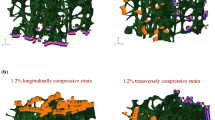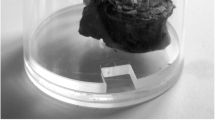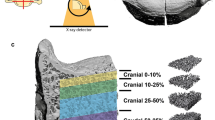Abstract
Cancellous centrum is a major component of the vertebral body and significantly contributes to its structural strength and fracture risk. We hypothesized that the variability of cancellous bone properties in the centrum is associated with vertebral strength. Microcomputed tomography (micro-CT)-based gray level density (GLD), bone volume fraction (BV/TV), and finite element modulus (E) were examined for different regions of the trabecular centrum and correlated with vertebral body strength determined experimentally. Two sets of images in the cancellous centrum were digitally prepared from micro-CT images of eight human vertebral bodies (T10–L5). One set included a cubic volume (1 per vertebral centrum, n = 8) in which the largest amount of cancellous material from the centrum was included but all the shell materials were excluded. The other set included cylindrical volumes (6 per vertebral centrum, n = 48) from the anterior (4 regions: front, center, left, and right of the midline of vertebra) and the posterior (2 regions: left and right) regions of the centrum. Significant positive correlations of vertebral strength with GLD (r 2 = 0.57, p = 0.03) and E (r 2 = 0.63, p = 0.02) of the whole centrum and with GLD (r 2 = 0.65, p = 0.02), BV/TV (r 2 = 0.72, p = 0.01) and E (r 2 = 0.85, p = 0.001) of the central region of the vertebral centrum were found. Vertebral strength decreased with increasing coefficient of variation of GLD, BV/TV, and E calculated from subregions of the vertebral centrum. The values of GLD, BV/TV, and E in centrum were significantly smaller for the anterior region than for the posterior region. Overall, these findings supported the significant role of regional variability of centrum properties in determining the whole vertebral strength.


Similar content being viewed by others
References
Banse X., Devogelaer J. P., Munting E., Delloye C., Cornu O., Grynpas M. Inhomogeneity of human vertebral cancellous bone: Systematic density and structure patterns inside the vertebral body. Bone 28(5):563–571, 2001
Buckley J. M., Leang D. C., Keaveny T. M. Sensitivity of vertebral compressive strength to endplate loading distribution. J. Biomech. Eng. 128(5):641–646, 2006
Buckley J. M., Loo K., Motherway J. Comparison of quantitative computed tomography-based measures in predicting vertebral compressive strength. Bone 40(3):767–774, 2007
Cao K. D., Grimm M. J., Yang K.-H. Load sharing within a human lumber vertebral body using the finite element method. Spine 12:E253–E260, 2001
Cendre E., Mitton D., Roux J. P., Arlot M. E., Duboeuf F., Burt-Pichat B., Rumelhart C., Peix G., Meunier P. J. High-resolution computed tomography for architectural characterization of human lumbar cancellous bone: Relationships with histomorphometry and biomechanics. Osteoporos. Int. 10(5):353–360, 1999
Cody D. D., Goldstein S. A., Flynn M. J., Brown E. B. Correlations between vertebral regional bone mineral density (rBMD) and whole bone fracture load. Spine 16(2):146–154, 1991
Cody D. D., Gross G. J., Hou F. J., Spencer H. J., Goldstein S. A., Fyhrie D. P. Femoral strength is better predicted by finite element models than QCT and DXA. J. Biomech. 32(10):1013–1020, 1999
Crawford R. P., Cann C. E., Keaveny T. M. Finite element models predict in vitro vertebral body compressive strength better than quantitative computed tomography. Bone 33:744–750, 2003
Cvijanovic O., Bobinac D., Zoricic S., Ostojic Z., Maric I., Crncevic-Orlic Z., Kristofic I., Ostojic L. Age- and region-dependent changes in human lumbar vertebral bone. Spine 29(21):2370–2375, 2005
Fyhrie D. P., Hoshaw S. J., Hamid M. S., Hou F. J. Shear stress distribution in the trabeculae of human vertebral bone. Ann. Biomed. Eng. 28(10):1194–1199, 2000
Hou F. J., Lang S. M., Hoshaw S. J., Reimann D. A., Fyhrie D. P. Human vertebral body apparent and hard tissue stiffness. J. Biomech. 31:1009–1015, 1998
Jacobs, C. R., B. R. Davis, C. J. Rieger, J. J. Francis, M. Saad, and D. P. Fyhrie. NACOB presentation to ASB Young Scientist Award: Postdoctoral. The impact of boundary conditions and mesh size on the accuracy of cancellous bone tissue modulus determination using large-scale finite-element modeling. North American Congress on Biomechanics. J. Biomech. 32(11):1159–1164, 1999
Kim D.-G., Christopherson G., Dong X. N., Fyhrie D. P., Yeni Y. N. The effect of microcomputed tomography scanning and reconstruction voxel size on the accuracy of stereological measurements in human cancellous bone. Bone 35:1375–1382, 2004
Kim D.-G., Dong X. N., Cao T., Baker K. C., Shaffer R. R., Fyhrie D. P., Yeni Y. N. Evaluation of filler materials used for uniform load distribution at boundaries during structural biomechanical testing of whole vertebrae. J. Biomech. Eng. 128:161–165, 2006
Kim D.-G., Hunt C. A., Zauel R., Fyhrie D. P., Yeni Y. N. Prediction of human vertebral body strength using microcomputed tomography-based finite element models from cancellous centrum with and without the cortical shell. Trans. Ortho. Res. Soc. 30:1265, 2005
Kopperdahl D. L., Roberts A. D., Keaveny T. M. Localized damage in vertebral bone is most detrimental in regions of high strain energy density. J. Biomech. Eng. 121(6):622–628, 1999
Kothari M., Keaveny T. M., Lin J. C., Newitt D. C., Majumdar S. Measurement of intraspecimen variations in vertebral cancellous bone architecture. Bone 25(2):245–250, 1999
Kuhn J. L., Goldstein S. A., Feldkamp L. A., Goulet R. W., Jesion G. Evaluation of a microcomputed tomography system to study trabecular bone structure. J. Ortho. Res. 8:833–842, 1990
Ladd A. J., Kinney J. H., Haupt D. L., Goldstein S. A. Finite-element modeling of trabecular bone: comparison with mechanical testing and determination of tissue modulus. J. Ortho. Res. 16(5):622–628, 1998
Liebschner M. A., Kopperdahl D. L., Rosenberg W. S., Keaveny T. M. Finite element modeling of the human thoracolumbar spine. Spine 28(6):559–65, 2003
McCubbrey D. A., Cody D. D., Peterson E. L., Kuhn J. L., Flynn M. J., Goldstein S. A. Static and fatigue failure properties of thoracic and lumbar vertebral bodies and their relation to regional density. J. Biomech. 28(8):891–899, 1995
Mitton D., Cendre E., Roux J.-P., Arlot M. E., Peix G., Rumelhart C., Babot D., Meunier P. J. Mechanical properties of ewe vertebral cancellous bone compared with histomorphometry and high-resolution computed tomography parameters. Bone 22(6):651–658, 1998
Old J. L., Calvert M. Vertebral compression fractures in the elderly. Am. Fam. Physician. 69:111–116, 2004
Reimann D. A., Hames S. M., Flynn M. J., Fyhrie D. P. A cone beam computed tomography system for true 3D imaging of specimens. Appl. Radiat. Isot. 48(10–12):1433–1436, 1997
van Rietbergen B., Weinans H., Huiskes R., Odgaard A. A new method to determine trabecular bone elastic properties and loading using micromechanical finite-element models. J. Biomech. 28(1):69–81, 1995
Ruegsegger P., Koller B., Mueller R. T. A microtomographic system for the nondestructive evaluation of bone architecture. Calc. Tiss. Int. 58:24–29, 1996
Sankoh A., Huque M., Dubey S. Some comments on frequently used multiple endpoint adjustments methods in clinical trials. Stat. Med. 16:2529–2542, 1997
Silva M. J., Keaveny T. M., Hayes W. C. Load sharing between the shell and centrum in the lumbar vertebral body. Spine. 22(2):140–150, 1997
Simpson E. K., Parkinson I. H., Manthey B., Fazzalari N. L. Intervertebral disc disorganization is related to trabecular bone architecture in the lumbar spine. J. Bone. Min. Res. 16(4):681–687, 2001
Ulrich D., van Rietbergen B., Weinans H., Ruegsegger P. Finite element analysis of trabecular bone structure: a comparison of image-based meshing techniques. J. Biomech. 31:1187–1192, 1998
Un K., Bevill G., Keaveny T. M. The effects of side-artifacts on the elastic modulus of trabecular bone. J. Biomech. 39:1955–1963, 2006
Yeh O. C., Keaveny T. M. Biomechanical effects of intraspecimen variations in trabecular architecture: a three-dimensional finite element study. Bone 25(2):223–228, 1999
Yeni Y. N., Christopherson G., Dong X. N., Kim D.-G., Fyhrie D. P. Effect of microcomputed tomography voxel size on the finite element model accuracy for human cancellous bone. J. Biomech. Eng. 127(1):1–8, 2005
Yeni Y. N., Dong X. N., Cao T., Baker K. C., Schaffer R. R., Fryhrie D. P. Evaluation of filler materials used for uniform load distribution at boundaries during structural biomechanical testing of whole vertebrae. Trans. Ortho. Res. Soc. 29:1116, 2004
Yeni Y. N., Fyhrie D. P. Finite element predicted apparent stiffness is a consistent predictor of apparent strength in human cancellous bone tested with different boundary conditions. J. Biomech. 34(12):1649–1654, 2001
Yeni Y. N., Hou F. J., Vashishth D., Fyhrie D. P. Trabecular shear stress in human vertebral cancellous bone: intra- and inter-individual variations. J. Biomech. 34(10):1341–1346, 2001
Zauel R., Yeni Y. N., Christopherson G. T., Cody D. D., Fyhrie D. P. Segmentation algorithm for accurate 3D representation of microcomputed tomographic images of human vertebral bodies. Trans. Ortho. Res. Soc. 29:1018, 2004
Acknowledgment
This publication was made possible by Grant Numbers AR049343 (YNY) and AR40776 (DPF) from the National Institutes of Health. Its contents are solely the responsibility of the authors and do not necessarily represent the official views of the NIH.
Author information
Authors and Affiliations
Corresponding author
Rights and permissions
About this article
Cite this article
Kim, DG., Hunt, C.A., Zauel, R. et al. The Effect of Regional Variations of the Trabecular Bone Properties on the Compressive Strength of Human Vertebral Bodies. Ann Biomed Eng 35, 1907–1913 (2007). https://doi.org/10.1007/s10439-007-9363-1
Received:
Accepted:
Published:
Issue Date:
DOI: https://doi.org/10.1007/s10439-007-9363-1




